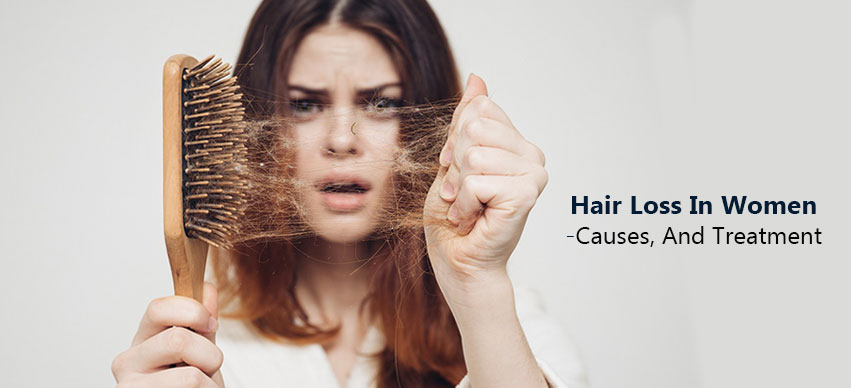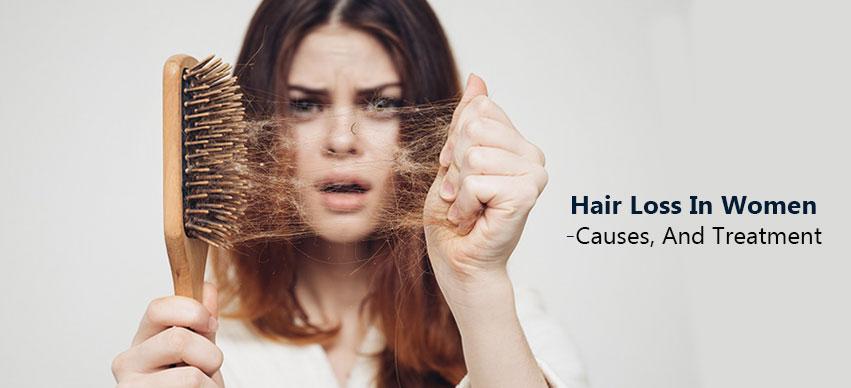How Communities Are Changing the Way We Think About Aging in..
8 Min Read


Experts agree that in order to effectively reduce hair loss, people have to identify the causes and eliminate them accordingly. Since there's no treatment that works for everyone, understanding the causes of your thinning hair will help you figure out the correct remedy for your condition. There are different forms and causes of hair loss in women. Here you will find the most important ones;
In most cases, hereditary hair loss, known as androgenic alopecia, is the reason why the hair thins and sheds since it affects the anagen phase — the stage where the hair is actively growing. Androgenic alopecia is mostly caused by the excessive production of testosterone, the male sex hormone (androgen), which converts to dihydrotestosterone (DHT) with the help of special enzymes. The presence of high levels of DHT are associated with the miniaturization of hair follicles and are believed to reduce the amount of time hair actively spends growing.
For a long time, it was believed that elevated testosterone levels were the main reason for hair shedding in women. However, studies found that only a small percentage of women suffering from hereditary hair loss present high levels of androgens. This is only occasionally the case, for example, in polycystic ovary syndrome (PCO syndrome).
Instead, the trigger seems to be the reduced activity of the enzyme aromatase and a genetic hypersensitivity of the hair follicles to androgens. Aromatase ensures the conversion of androgens to female-specific sex hormones (estrogens) within the hair follicles. Thus, the reduced enzyme activity increases the concentration of male sex hormones at the hypersensitive follicles. On the other hand, fewer female hormones are produced locally, which are said to have a promoting effect on hair growth. Overall, this results in hair loss.
In women, hereditary hair loss is characterized by a reduction in hair density over the crown and frontal scalp.
Minoxidil is the most effective treatment for hereditary hair loss in women, also approved by the Food and Drug Administration. It's applied locally as a two percent hair tonic twice a day to the thinning areas. This can stop the progression of hair loss and sometimes even encourage new hair growth. The exact mechanism of action of minoxidil is not known. Presumably, it stimulates blood flow in the small blood vessels, acting as a vasodilator.
Low-level laser therapy (LLLT) is another alternative for treating hereditary hair loss. It uses low-power lasers that emit photons into the scalp, which, once absorbed by the follicles, supports the hair growth process. LLLT was confirmed to prolong the duration of the anagen phase as well as increase the hair count in the growth stage. Popular at-home laser hair growth systems include iRestore, HairMax, and Capillus. They were found to improve hair growth in people suffering from androgenic alopecia, but they are just as effective for other conditions.
Sometimes doctors also prescribe tablets containing antiandrogens (such as cyproterone acetate) for androgenic alopecia. These are substances that cancel out the effect of male sex hormones. Before menopause, antiandrogens are used in combination with estrogens as contraceptives.
If a hormonal disorder such as PCO syndrome is behind your hair loss, the treatment of the underlying condition is the main priority. Extreme hair loss in women can often only be concealed with a hairpiece (toupee, wig). Some women also opt for hair transplants.
Other women instead lose hair in circular or patchy bald spots, manifesting as a receding hairline. This condition is called alopecia areata. It has different causes from androgenic alopecia, though they are not exactly understood.
Current data suggest that alopecia areata is caused by an abnormal autoimmune reaction that damages hair follicles. In other words, the antibodies of the immune system mistakenly attack the body's own healthy tissue — in this case, the cells in the hair roots. This disrupts the hair growth process and ultimately leads to hair loss. A genetic predisposition and other factors can also contribute to the development of alopecia areata in women.
Finally, menopause and stress are often the reasons which make the immune system attack your hair follicles.
There are multiple options available for the treatment of alopecia areata in women. For instance, the local applications of corticosteroid injections and dithranol. Cortisone inhibits the immune system, while dithranol is a skin irritant designed to stimulate new hair growth.
Topical immunotherapy is also an effective treatment for hair loss. In this case, allergic contact dermatitis is intentionally triggered on the affected skin areas, which is supposed to "distract" the misdirected immune system from attacking the hair root cells.
The chances of success of the individual treatment options for circular hair loss are relatively modest.
Here hair loss occurs evenly all over the head and oftentimes is just a temporary condition. According to research, telogen effluvium (TE) is the most common cause of diffuse hair loss in adult women, manifesting as abnormal hair shedding. Telogen effluvium is triggered when an increased number of hairs prematurely enters the resting phase (telogen), where is not actively growing.
Often, certain medications lead to telogen effluvium. These include, for example, cytostatics, drugs for hyperthyroidism (thyreostatics), beta-blockers (for heart disease), lipid-lowering drugs (for elevated blood fat levels), anticoagulants, and vitamin A preparations.
In other cases, diffuse hair loss in women is due to a metabolic disorder. This can be a protein or iron deficiency, for example, in the context of malnutrition. Hyperthyroidism, as well as hypothyroidism, is another common reason for excessive hair loss. Severe infection with high fever could also trigger excessive hair shedding. Many women also present increased hair loss after childbirth.
The persistent or frequent pulling on the hair roots can cause the affected hair to fall out prematurely, called traction alopecia. This is observed, for example, in women who often wear a tight ponytail. Here, hair loss primarily affects the area of the forehead and temples.
The loss of hair accompanied by scarring is called cicatricial alopecia. Scarring alopecias are caused by inflammation and tissue damage that destroys hair follicles, leading to irreversible hair loss. You can differentiate this condition from others if the affected area shows signs of inflammation, redness, or itchiness.
The treatment of hair loss in women is not a one-fit-all situation. It mostly depends on what causes the condition.
For example, if certain medications cause diffuse hair loss, affected people should talk to their doctor. They should recommend reducing the dose or switching treatment to an alternative preparation that is less harmful to hair follicles. If that's the case, hair loss usually reduces on its own once drug treatment is stopped.
If diseases (such as hyperthyroidism, tuberculosis, etc.) or poisoning trigger hair loss, these must be treated professionally.
The treatment of cicatricial alopecia is complicated. Cortisone and other active substances can be prescribed to treat the inflamed areas of the scalp, which stops the inflammatory processes. However, the hair that has already been lost will not grow back because the damage caused to hair follicles is irreparable. Hair follicles also can't be revived once they have been destroyed by inflammations.
Mechanically induced hair loss, or traction alopecia, can be prevented by not subjecting the hair roots to excessive traction. This means less ponytails and less aggressive brushing.
Last but not least, the temporary hair loss in women triggered after childbirth, surgery, or infection usually does not require treatment, and the hair recovers on its own.